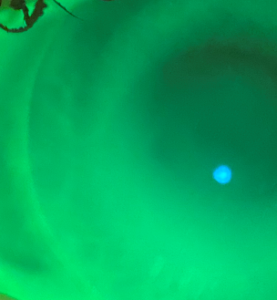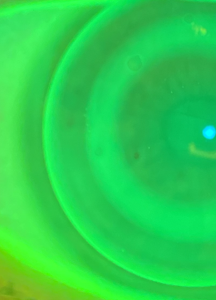sponsored content
June 15, 2022
While orthokeratology has been around for decades, its popularity in the West is growing exponentially thanks to its ability to limit axial length growth in children and young adults.
This interest has fueled a resurgence in research and development with new designs and features coming to market each year. The ability to collect data, customize lenses, and ensure the proper treatment is now achievable with relative ease for most standard cases.
History
A 9-year-old female patient presented with her parents for orthokeratology consultation. Her parents were both myopic, and her mother was status-post LASIK OU. Her father wears spectacles full-time. The patient has been complaining of difficulty seeing the board at school, and her parents say that she is unable to read the guide on the television.
The patient claims that the blur started a few months back and seems to be getting progressively worse. Her medical and ocular history were unremarkable aside from seasonal allergies, and her only medication was an over-the-counter antihistamine.
Examination
Entering acuity uncorrected
OD: 20/80
OS: 20/100
OU: 20/60
K’s
OD: flat 42.00 180 steep 43.25 090
OS: flat 42.00 178 steep 43.00 088
MR:
-1.75-0.75×010 20/20
-2.00-0.50×175 20/20
HVID 11.7 OU
Ocular health unremarkable OU
It was determined that the patient was a good candidate for orthokeratology. Her refraction and corneal curvature are ideal for the treatment, and her seasonal allergies would degrade daily wear soft lens success. She is at an age that would see significant benefit in the slowing of axial length elongation, especially with a strong family history of myopia. Risk and benefits were discussed along with alternatives, including soft multifocal contacts, atropine therapy, and standard contact lenses and spectacles. The parents elected to proceed with orthokeratology treatment for the aforementioned reasons, and lenses were empirically ordered using the REMLens online calculator.
Follow Up
The patient’s lenses were dispensed and showed good centration. The fluorescein pattern looked great centrally but showed minimal edge lift OU. Her lens over-refraction was +0.75D, and she saw 20/20 in each eye. She did great during care and handling training and was released to wear the lenses and return in the morning wearing the lenses into the office.
 The next morning the patient returned after successfully wearing the lenses overnight. The lenses were removed but with some difficulty as they seemed tightly adhered. The patient was 20/20 in both eyes after removal with trace central stain in both eyes.
The next morning the patient returned after successfully wearing the lenses overnight. The lenses were removed but with some difficulty as they seemed tightly adhered. The patient was 20/20 in both eyes after removal with trace central stain in both eyes.
The patient returned one week later for an afternoon appointment. Her refraction was +0.25 DS OD and +0.50 DS OS with 20/20 vision in both eyes. She and her parents were happy with her vision and overall experience except that removal of the lens continued to be an issue in the morning. Based on this and the insufficient edge lift seen at dispensing, we decided to adjust the edge lift using the Dynamic Edge Profile. We ordered a “flat 3” that increased the sagittal depth (decreased the angle) of the edge by 30 microns. The patient was to pick up the new lenses and return to the office one week later for a check-up.
 |
 |
Upon return, the topography and vision remained stable, but the parents said that the morning adhesion trouble was greatly diminished with the new flatter edge profile. The central stain had also resolved, and the patient was released for three months.
The Dynamic Edge Profile Ensures Patient Comfort
The Dynamic Edge is a unique design characteristic of the REMLens orthokeratology platform. The peripheral curve of an orthokeratology lens might not directly affect treatment, but it is as important as any other curve when it comes to treatment success. Without proper lift around the entire edge, seal-off might not be achieved throughout the alignment zone, inhibiting the hydrodynamic force necessary under the center and reservoir zone needed to achieve proper molding. Insufficient edge lift can also lead to seal-off in the morning, making removal difficult and uncomfortable. Excessive edge lift leads to lid interaction and lens intolerance that often can negatively impact compliance in patients of all ages. Excessive lid interaction can also cause decentration if the lids are able to mechanically “grab” and manipulate lens positioning.
For these reasons, the Dynamic Edge Profile of the REMLens offers a unique advantage to ensure proper treatment and comfort when utilizing the Rapid Eye Molding System. Easy and predictable independent edge manipulation ensures fitters that they have the ability to troubleshoot issues along the peripheral curve without negatively impacting the integrity of the treatment zone.
The Dynamic Edge is easy to control with “steep” (increase/tighten edge angle) and “flat” (decrease/loosen edge angle) movements to tighten or loosen the edge. These can move over a range of 60 microns in 10-micron steps.
This article is sponsored by X-Cel Specialty Contacts.














